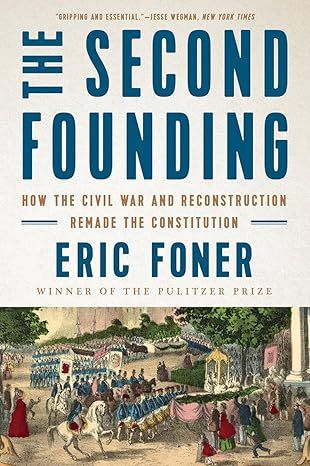The Second Founding: How the Civil War and Reconstruction Remade the Constitution
4.7
-
1,102 ratings
“Gripping and essential.”―Jesse Wegman, New York Times
An authoritative history by the preeminent scholar of the Civil War era, The Second Founding traces the arc of the three foundational Reconstruction amendments from their origins in antebellum activism and adoption amidst intense postwar politics to their virtual nullification by narrow Supreme Court decisions and Jim Crow state laws. Today these amendments remain strong tools for achieving the American ideal of equality, if only we will take them up.
Kindle
$9.99
Available instantly
Audiobook
$0.00
with membership trial
Hardcover
$4.39
Paperback
$16.63
Ships from
Amazon.com
Payment
Secure transaction
ISBN-10
0393358526
ISBN-13
978-0393358520
Print length
304 pages
Language
English
Publisher
W. W. Norton & Company
Publication date
August 10, 2020
Dimensions
5.5 x 0.8 x 8.3 inches
Item weight
8.3 ounces
Product details
ASIN :
B07P769MSX
File size :
10144 KB
Text-to-speech :
Enabled
Screen reader :
Supported
Enhanced typesetting :
Enabled
X-Ray :
Not Enabled
Word wise :
Enabled
Editorial Reviews
"Disciplined, powerful and moving.… [An] important book." ― Lincoln Caplan, New York Times Book Review
"Lucid and succinct." ― John Fabian Witt, Washington Post
"Sometimes a book makes you reconsider a subject you’ve studied all of your adult life." ― Adam Liptak, Supreme Court correspondent, New York Times
"Brisk but far-reaching.… [C]opies of this book should be spread around the capital, because the battles of contemporary Washington are but a second act to the struggles prompted by Foner’s Second Founding." ― David M. Shribman, Boston Globe
"The Second Founding… demonstrates [Foner’s] talent at unearthing insights about the Civil War and Reconstruction eras, in particular how Americans defined and acted on the ideals of freedom and democracy.… [He writes] in what another eminent historian, Christopher Lasch, called ‘plain style’: direct and vivid prose without a trace of specialized language, which anyone with a passing interest in the subject can read, learn from, and enjoy." ― Michael Kazin, Nation
"As the dean of Reconstruction studies, Foner is the ideal scholar to produce a history of the three amendments added to the Constitution during the period―amendments so powerful as to justify the book’s title." ― James Oakes, New York Review of Books
"Mr. Foner makes his case with brio and erudition." ― Fergus M. Bordewich, Wall Street Journal
"In this moment, indeed in any, Eric Foner’s new book is uncommonly valuable." ― W. Fitzhugh Brundage, Washington Examiner
"With The Second Founding, Foner offers a taut, absorbing companion piece to his magisterial Reconstruction, published three decades ago." ― Hamilton Cain, Minneapolis Star Tribune
"[The Second Founding] should land on the desk of every federal jurist.… [It] presents a sobering picture of the use and misuse of history in legal battles over race. But it is hopeful too. Change is possible with more truthful and expansive historical knowledge." ― Amy Murrell Taylor, Times Literary Supplement
Sample
INTRODUCTION
Origins of the Second Founding
THE PROFOUND changes that American society experienced during the Civil War and Reconstruction and how they reshaped the Constitution and the broad legal and political culture cannot be understood without reminding ourselves of the status of African-Americans when the war began. There were a little under four million slaves and half a million free blacks in the United States in 1860. Slavery was politically powerful and economically thriving. Slave-grown cotton was by far the nation’s most important export, and the profits generated by slavery enriched not only planters in the South but also merchants, manufacturers, and bankers in the free states.
Slavery’s growth and power depended, in part, on protections provided by the Constitution. In 1787, at the time of the Constitutional Convention, around 700,000 slaves lived in the United States. They made up 40 percent of the population of the states from Maryland to Georgia. Of the fifty-five delegates nearly half, including a number of northerners, possessed slaves. George Washington, who presided, owned over two hundred, three of whom accompanied him to Philadelphia, where the convention took place. The Constitution did not mention the word “slavery,” but clearly referred to slaves in such circumlocutions as “other persons” and “person held to service or labor.” Nonetheless, many of the framers, including slaveholders from the Upper South, hoped that the institution would eventually die out, and they successfully resisted efforts to place an explicit national recognition of property in man in the document. Yet they did include clauses requiring the return of fugitive slaves to their owners, allowing states to import slaves from abroad for at least the next twenty years, and according southern states extra power in the House of Representatives by counting three-fifths of their slave population in apportioning its members. This last provision also enhanced southern power in the Electoral College that chooses the president.
Most importantly, perhaps, it was almost universally agreed that the Constitution left slavery beyond the reach of the national government. State law established and maintained slavery and states could abolish slavery or prohibit its establishment, as northern states did during and after the War of Independence. But debates over slavery nearly always acknowledged what came to be called the “federal consensus”—that the national government had no power to take direct action against the institution in the states. As the country expanded, a rough balance was maintained between free states and slave. Since changes to the Constitution require approval by two-thirds of Congress and three-quarters of the states, an amendment abolishing slavery was clearly out of the question. The historian Linda Colley has observed that written constitutions often function as “weapons of control” rather than “documents of liberation and rights.” As far as slaves were concerned, this certainly applies to the original Constitution. Of course, no black persons took part in the Constitutional Convention; nor did women, Native Americans, or poorer whites. Perhaps the second founding can be seen as a step toward making the Constitution what it might have been if “We the People” (the document’s opening words) had been more fully represented at Philadelphia.
Slavery shaped the definition of American citizenship before the Civil War, giving it a powerful racial dimension. A nation, in Benedict Anderson’s celebrated phrase, is more than a political entity—it is also “an imagined political community,” whose borders are as much intellectual as geographic. Slavery rendered blacks all but invisible to those imagining the American community. When J. Hector St. John de Crèvecoeur, an immigrant from France who gained renown for popularizing facts and myths about the new republic during the era of the Revolution, posed his famous question, “What then is the American, this new man?” he answered, “a mixture of English, Scotch, Irish, French, Dutch, Germans, and Swedes. . . . He is either a European, or the descendant of a European.” At the time, fully one-fifth of the population (the highest proportion in our history) consisted of Africans and their descendants.
In British law, the American colonists, like persons in Great Britain, were “subjects” of the crown, entitled to protection and required to provide allegiance. Independence transformed British subjects into American citizens. Yet despite the enormous “cultural currency” that the idea of citizenship acquired in the United States in the first half of the nineteenth century, it was not until the constitutional revolution of Reconstruction that a commonly agreed-upon understanding of the rights it entailed and the role of the federal government in defining and guaranteeing those rights developed. Before the Civil War, as one member of Congress noted during Reconstruction, a person seeking enlightenment about American citizenship “must have been pained by the fruitless search in the law books and the records of our courts for a clear and satisfactory definition of the phrase ‘citizen of the United States.’ ” During the early days of Reconstruction, members of Congress asked Horace Binney, a prominent lawyer and a former congressman, to explore the meaning of citizenship. “The word citizen,” he responded, “is found ten times at least in the Constitution of the United States, and no definition of it is given anywhere.”
The Constitution’s “Comity Clause” states that the citizens of each state are “entitled to all privileges and immunities of citizens in the several states,” language that seems to suggest that the rights of citizens are determined by the states, not the federal government. The Constitution does require the president to be a “natural-born Citizen,” that is, a person born in the country. This implies, but does not state explicitly, that citizenship derives either from birth in the United States or, for immigrants from abroad, a “naturalization” process. On occasion, the federal government created American citizens by purchasing the land on which they lived, for example the Louisiana Territory acquired from France, or via conquest, as in the Mexican-American War. In both cases, the residents (except, in the latter case, members of “savage tribes”) could choose to become American citizens if they so desired.
Citizenship certainly did not imply equality. Whites, male and female, born in the United States were commonly assumed to be citizens, but white women lacked basic rights enjoyed by men. Slaves were not citizens, but the status of free black Americans remained highly controversial. The first Naturalization Act, approved by Congress in 1790, limited the process of becoming a citizen from abroad to white persons. What of free blacks born in the United States? At the time of ratification, most of the original states, including some in the South, allowed free black men to vote if they met the property or other qualifications. As time went on, however, the slave states placed severe restrictions on their lives and increasingly refused to recognize them as citizens. Some northern states did, however, and all accorded them basic rights such as property ownership, trial by jury, and the ability to hold public meetings, publish newspapers, and establish their own churches. But nowhere did free African-Americans enjoy full equality before the law. Their situation was anomalous—one jurist referred to free blacks as “quasi citizens.”
In the decades before the Civil War, the Constitution’s Comity Clause did not seem to apply to African-Americans. A number of states, northern as well as southern, prohibited free black persons from entering their territory. In the 1790s and early nineteenth century, the federal government issued certificates of citizenship to black sailors, to prevent their impressment by the British navy. But several southern states incarcerated free black sailors whose vessels docked in the state, even though they had not been accused of any crime. The enforcement of South Carolina’s draconian law led to a strong protest from Massachusetts, which recognized blacks as citizens, and also from Great Britain, to whose black seamen it also applied, but to no avail. The Comity Clause became an issue during the 1820–21 debates over the admission of Missouri, whose constitution not only established slavery but barred the entry of free blacks. Many northerners objected to the latter provision. As part of the Missouri Compromise, the state was admitted on the condition that its constitution should not be construed as denying to any citizens the privileges and immunities to which they were entitled, without enumerating what these might be or whether they applied to free blacks.
In a country that lacked more traditional bases of nationhood—long-established physical boundaries; historic ethnic, religious, and cultural unity; a powerful and menacing neighbor—American political institutions became a point of unity and self-definition. Those denied the suffrage, wrote one advocate of democratic reform, were “put in the situation of slaves of Virginia.” Increasingly, the right to vote became the emblem of American citizenship, if not in law (since suffrage qualifications were determined by the individual states) then in common usage and understanding. Noah Webster’s American Dictionary noted that in the United States, but not in Europe, the word “citizen” had, by the 1820s, become synonymous with the right to vote. Of course, Webster was writing about men; white women were certainly citizens although denied the suffrage. But with the exception of Maine, every state that entered the Union between 1800 and the Civil War limited the suffrage to white men, and over time some of the original states rescinded blacks’ right to cast a ballot. On the eve of conflict, black men enjoyed the same right to vote as their white counterparts in only five of the thirty-four states, all in New England. The identification of the polity—and citizenship itself—as a realm for white men became “so natural and necessary as to be self-evident,” as one historian has put it.
As Alexis de Tocqueville observed, a passion for equality animated American democracy. But the concept of equality before the law—something enjoyed by all persons regardless of social status—barely existed before the Civil War. Belief in equality coexisted with many forms of second-class citizenship. Individuals’ rights were determined by numerous factors, including race, ethnicity, gender, and occupation. Unequal status relations were built into the combination of local laws, judicial rulings, and customs known as the common law. In “a common law court,” Senator Jacob M. Howard of Michigan declared during the Civil War, the idea of equality before the law was “not known at all.” In accordance with the common law of coverture, most of the rights of married women were exercised by their husbands. The common law of master and servant distinguished sharply between the rights and powers of employers and employees. Rights often included the ability to exercise authority over others—as in the case of slaveholders, employers, fathers, and husbands. This is one reason why the extension of rights to African-Americans during Reconstruction was seen by many whites as taking something away from them.
Antebellum political and legal discourse divided rights into distinct categories, not all of which every citizen enjoyed. Most basic were natural rights, such as the “unalienable” rights enumerated by Thomas Jefferson in the Declaration of Independence. Every person, by virtue of his or her human status, was entitled to life, liberty (even though this principle was flagrantly violated by the existence of slavery), and the pursuit of happiness (often understood as the right to enjoy the fruits of one’s own labor and rise in the social scale). Civil rights, the second category, included legal entitlements essential to pursuing a livelihood and protecting one’s personal security—the right to own property, go to court, sue and be sued, sign contracts, and move about freely. These were fundamental rights of all free persons, but they could be regulated by the state. Married women, for example, could not engage in most economic activities without the consent of their husbands, and many states limited the right of blacks to testify in court in cases involving whites. Then there were political rights. Legally, despite Webster’s dictionary, access to the ballot box was a privilege or “franchise,” not a right. It was everywhere confined to men, and almost everywhere to white men. Finally there were “social rights,” an amorphous category that included personal and business relationships of many kinds. These lay outside the realm of governmental supervision. Every effort to expand the rights of blacks was attacked by opponents as sure to lead to “social equality,” a phrase that conjured up images of black-white sexual intimacy and interracial marriage.
Read more
About the authors
Eric Foner
Eric Foner is DeWitt Clinton Professor of History at Columbia University, where he earned his B.A. and Ph.D. In his teaching and scholarship, Foner focuses on the Civil War and Reconstruction, slavery, and nineteenth-century America. His "Reconstruction: America’s Unfinished Revolution, 1863–1877," won the Bancroft, Parkman, and Los Angeles Times Book prizes and remains the standard history of the period. In 2006 Foner received the Presidential Award for Outstanding Teaching at Columbia University. He has served as president of the Organization of American Historians, the American Historical Association, and the Society of American Historians. He is currently writing a book on Lincoln and slavery.
Read more
Reviews
Customer reviews
4.7 out of 5
1,102 global ratings
Ryan Boissonneault
5
How the ideal of equality was built into the Constitution
Reviewed in the United States on September 23, 2019
Verified Purchase
We shouldn’t forget that the original United States Constitution, for all its brilliance, did explicitly condone the practice of slavery. For example, the “three-fifths compromise” counted slaves as three-fifths of a person for the purpose of calculating state representation in Congress, while Article 1, Section 9, Clause 1 prohibited Congress from passing laws banning slavery until 1808. Additionally, Article 4, Section 2 states, in essence, that escaped slaves must be returned to their owners in the original state from which they fled.
In other words, the Constitution was far from perfect (luckily, it allowed for its own modification). And that’s why many historians consider the “second founding” during the Reconstruction era to be of equal or greater significance than the founding itself. The Reconstruction era that followed the Civil War saw the passage of three amendments that would forever transform politics in the US, both in terms of civil rights and in the balance of power between the federal government and the states.
In “The Second Founding,” historian and Reconstruction expert Eric Foner tells the story of how these three amendments—the thirteenth, fourteenth, and fifteenth—together represent the foundation for the continuing struggle for universal rights. The abolition of slavery, birthright citizenship, equal protection under the laws, universal suffrage, and the Incorporation Doctrine (which forces the states to honor the Bill of Rights) are all the direct or indirect result of these three crucial amendments. And yet the “second founding” remains less well-known among the public than the first.
This book is the remedy for that gap in public knowledge, and is invaluable for understanding not only the Reconstruction era but also the subsequent civil rights movements and the modern conservative attack on equality. Foner shows, for example, how talk of “state rights” has almost always been a cover for blatant discrimination. “State rights” has variously meant the right to enslave, the right to deny the vote to blacks and women, the right to violate the Bill of Rights, and the right to discriminate based on race and gender. As Foner wrote, “Before the war, for example, southern states adopted laws making criticism of slavery a crime without violating the First Amendment since these were state laws and not acts of Congress.” The real danger, in terms of rights violations, has always been greater within the individual states.
This book can also act as a good inoculant against conservative rhetoric that hasn’t changed in at least 156 years. The reader will be amused to find the same state’s rights and reverse discrimination arguments throughout the book. Andrew Johnson, for example, in his opposition to the fourteenth amendment, said, “The distinction of race and color is by the bill made to operate in favor of the colored against the white race.” As Foner wrote, “In the idea that expanding the rights of nonwhites somehow punishes the white majority, the ghost of Andrew Johnson still haunts our discussions of race.”
The underlying message of the book seems to be that any rights granted by the Constitution are worthless if not enforced. Constitutional rights can be ignored, distorted, or narrowly interpreted to deprive certain groups of equal protection and treatment under the law. But if we can’t even recognize when this is happening—and we don’t properly understand what the second founding was trying to accomplish—then we are all powerless to prevent a regression to discriminatory politics under the guise of “state’s rights,” “originalism,” and all the rest.
Read more
131 people found this helpful
aar4
5
Brilliant, readable, and important
Reviewed in the United States on October 11, 2020
Verified Purchase
In this concise book, Prof. Foner explains the Civil Rights Amendments -- the 13th, 14th, and 15th -- and demonstrates gracefully the importance they held then and do now. Not only scholars and academics, but the general reader will find this a fascinating and enlightening work.
Robert C. Smith
5
A failure of epic proportions
Reviewed in the United States on March 8, 2020
Verified Purchase
A fabulous and timely history. Foner is the foremost authority on Reconstruction and the post Civil War period. It is heartbreaking to learn how quickly the promise of ending slavery and ensuring voting rights for African Americans was thwarted by pure politics. To understand how Jim Crow began and how the federal government abdicated its responsibilities to make good on the ideals of the Declaration of Independence and the Constitution is a shock. Shame will continue to adhere to our political leaders until they right these centuries-long injustices. No one can fully understand our history and our present political dilemmas until they read this book. Eric Foner is a true giant of American historians.
Read more
5 people found this helpful
M. Bailey
5
Essential to understanding US History
Reviewed in the United States on October 11, 2019
Verified Purchase
This book would be required reading in my US History class if I had one. Growing up in the 50's and 60's in Oklahoma City, I witnessed first hand segregated busses and other public facilities. My children and grandchildren do not know of that world without reading the historical source of those times. And the residue is still with us in gerrymandering to isolate and minimize minority districts and the current voter suppression efforts. The segregationists learned how to concoct election laws targeting blacks but using language that appeared neutral. Now the voter suppression folks are using that same playbook. My granddaughter should experience going out of town on a school sanctioned overnight trip and having her African-American friend and teammate forced to stay in a "black" hotel!
Read more
38 people found this helpful
Stephen Zielinski
5
Racism over law
Reviewed in the United States on December 4, 2020
Verified Purchase
Reading Eric Foner’s work on the Reconstruction Era ought to correct any belief a rational student of the texts might have regarding the beneficial consequences of the Civil War and the operations of the post-bellum Supreme Court. Even the Civil War Amendments, which share in the authority that issues from the text of the Constitution of 1787 and the Bill of Rights, were neutralized in practice by a resurgent race politics in the South and by the mindless federalism of the Supreme Court. We live today with their mistakes and crimes, as Foner reminds us in this essential text.
Read more
2 people found this helpful
Similar Books
Best Sellers

The Great Alone: A Novel
4.6
-
152,447
$5.49

The Four Winds
4.6
-
156,242
$9.99

Winter Garden
4.6
-
72,838
$7.37

The Nightingale: A Novel
4.7
-
309,637
$8.61

Steve Jobs
4.7
-
24,596
$1.78

Iron Flame (The Empyrean, 2)
4.6
-
164,732
$14.99

A Court of Thorns and Roses Paperback Box Set (5 books) (A Court of Thorns and Roses, 9)
4.8
-
26,559
$37.99

Pretty Girls: A Novel
4.3
-
88,539
$3.67

The Bad Weather Friend
4.1
-
34,750
$12.78

Pucking Around: A Why Choose Hockey Romance (Jacksonville Rays Hockey)
4.3
-
41,599
$14.84
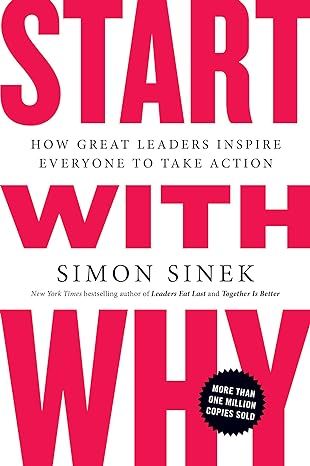
Start with Why: How Great Leaders Inspire Everyone to Take Action
4.6
-
37,152
$9.99

Tomorrow, and Tomorrow, and Tomorrow: A novel
4.4
-
95,875
$13.99

Weyward: A Novel
4.4
-
27,652
$11.99

Tom Lake: A Reese's Book Club Pick
4.3
-
37,302
$15.74

All the Sinners Bleed: A Novel
4.4
-
12,894
$13.55
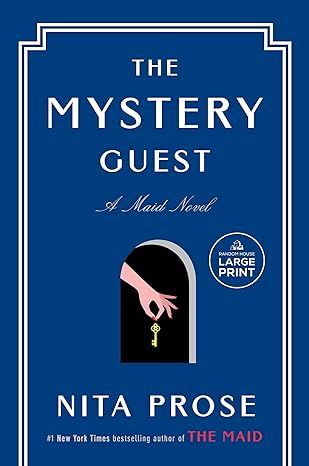
The Mystery Guest: A Maid Novel (Molly the Maid)
4.3
-
9,844
$14.99

Bright Young Women: A Novel
4.2
-
8,485
$14.99

The Wager: A Tale of Shipwreck, Mutiny and Murder (Random House Large Print)
4.5
-
28,672
$14.99

Hello Beautiful (Oprah's Book Club): A Novel (Random House Large Print)
4.4
-
79,390
$14.99
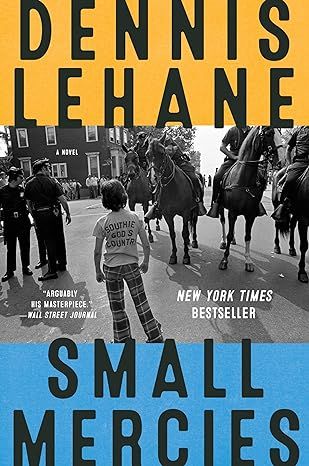
Small Mercies: A Detective Mystery
4.5
-
16,923
$10.00

Holly
4.5
-
31,521
$14.99
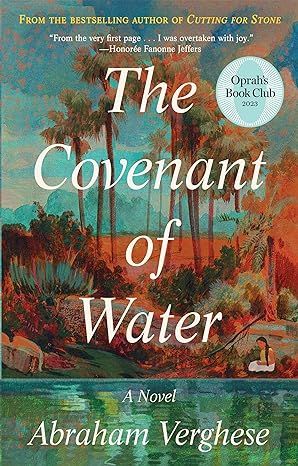
The Covenant of Water (Oprah's Book Club)
4.6
-
69,712
$9.24

Wellness: A novel
4.1
-
3,708
$14.99
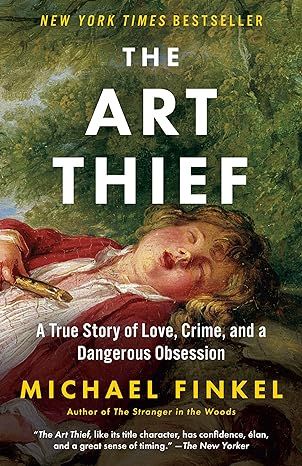
The Art Thief: A True Story of Love, Crime, and a Dangerous Obsession
4.3
-
4,805
$14.99
